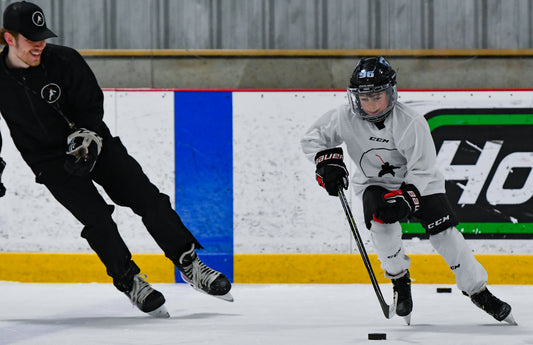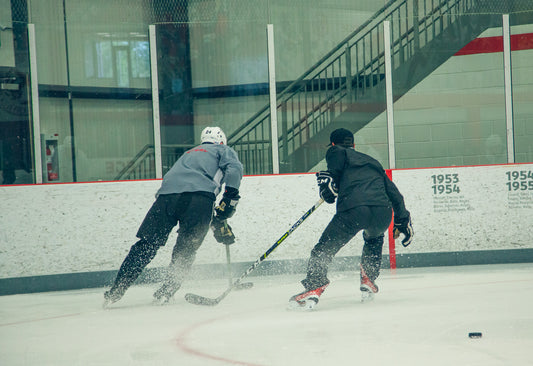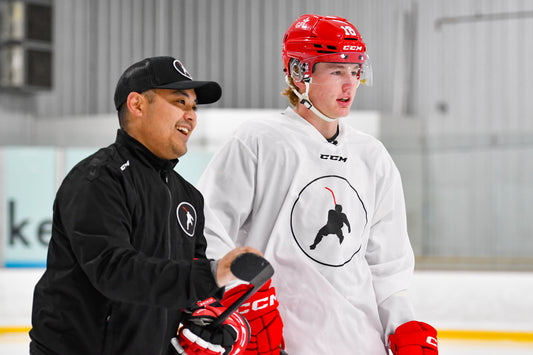It’s pretty cool to see how all of us hockey people are all very different. We have different personalities, different ways of thinking and different ways of playing the game. But even with all of these differences we are all coming to the same conclusion: ‘One and Done’ plays just don’t get anything done. Steve Stamkos talked about it before Game 2 of their clash with the NJ Devils just this past weekend. Sustained pressure that causes consecutive chances is what’s getting results these playoffs. He talked about how important it is to get more OZ time. But how? It’s all about keeping plays alive.
For the speedy player
If you’ve got tremendous footspeed, getting a loose puck retrieval (LPR) and poking the puck East-West, chipping it to short support or spinning off checks are going to be your bread and butter to keeping plays alive. You create races for the puck because you usually win them. Most players do not have natural tremendous footspeed. We will talk more about these players in an upcoming blog.
What about if you’re not so fleet of foot?
You will have to be a little more creative and to have a plan for the puck before you get possession. You can use your reach to chip pucks to open areas, quick stick handling to pull the puck into protected areas, or even just some smaller more focused movement to pop into holes. These moves are perfected by some of the guys we’ve traded sweat with like Joe Pavelski and James Neal. These guys are great examples of how the powerful player keep plays alive. In this video, you can see how Neal isn’t going to win the race down the wall, so he uses his reverse skinner to suck the defender in. Once the defender bites, Neal can transition back to forward with a step on the defender. This is also a great area pass by Schmidt to get Neal the puck with time and space to make a play.What if you’re a D? What can you do to keep plays alive?
A big one that comes to mind is shortening and sealing the wall. What’s shortening? And no, not the baking stuff ☺. It’s when a defenseman pressures down the wall in the OZ on the opposing team’s winger in an effort to keep the play alive and sustain more OZ pressure, some people call this pinching. As a forward, we love these types of guys, believe me, we’d rather move 5 feet and be attacking in the OZ than moving 40 feet back into the NZ and regrouping for a second wave of attack. Another big one is making good puck decisions on the offensive blue. Becoming a smart shooter and moving pucks into soft areas of the ice to sustain offensive pressure are concepts and skills that need to be repped to maximize performance.
Moving pucks to open areas
All the best players do it. An area pass is a pass that isn’t directly onto a players tape but is to an area of the ice where a teammate can win the race. As analytics become so much more important and sought after, we can’t ignore how area passes correlate with higher possession numbers. Just take a look at Sid’s shifts in Game 3 against Philly. He’s constantly throwing pucks under pressure to areas where it seems like no one is there. But Letang swoops in, and then Guentzel swoops in. Sid is a master of keeping plays alive. Another great example is the OT winner in game 2 of the Vegas-LA series. In the 2nd OT, James Neal weaved into the NZ to create offensive gap (another awesome concept) and cut into the middle of the ice just inside the offensive blue. It created an offense right flank lane and Neal just popped a beautiful skilled forehand pass with his hands in tight to a streaking Haula, red light baby. Game over. Area Pass 101. It’s beautiful and it works.
Stay away from “One and Done’s”
We had a chance to watch a bunch of minor hockey this weekend too and we couldn’t help but notice so many ‘One and Done’ plays. The problem was that the players did not have the mentality of trying to sustain offensive pressure. This lead players to ‘watching’ the puck rather than staying on the puck and supporting the puck and puck carrier. Stay tuned for an upcoming blog about ‘watching’. It’s a national epidemic in today’s game and as a result, we, as coaches, are trying to teach and inspire it out of the game.
So, next time you’re thinking about trying to sustain offensive pressure, think about keeping plays alive within the different context listed above. Focus on the situations, timing and skills that will be needed to be sharp to execute. Find inspiration and motivation from qualified coaches to avoid slipping into the condition of “watching” and make that behavior part of your DNA.
No more “One and Done’s”. The best players in the world are keeping plays alive and with focus, commitment and a great support team around you, so can you.




